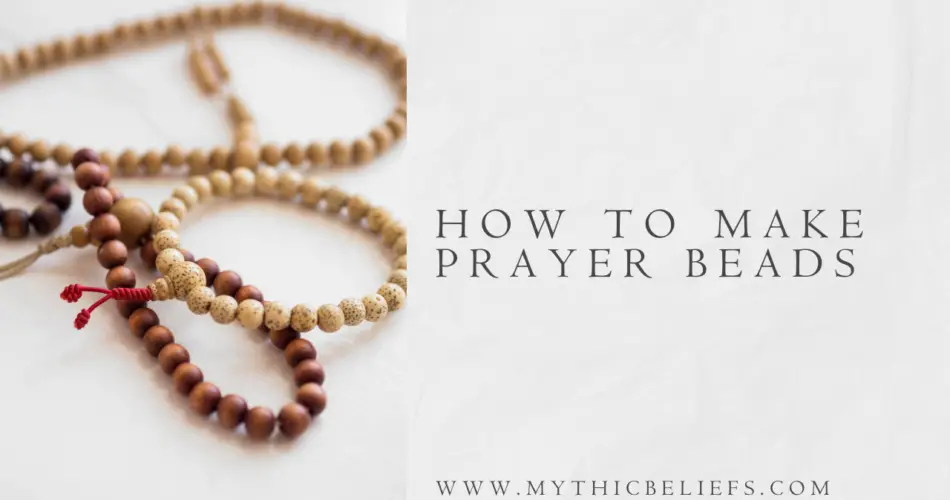Prayer beads have been around for centuries, used by countless cultures and religions to aid in meditation, focus, and prayer. Whether it’s a Catholic rosary, Buddhist mala, or Islamic misbaha, these beads serve as a tangible connection to spirituality. But beyond their religious significance, making your own prayer beads can be a deeply personal and even therapeutic experience. There’s something special about crafting something with your own hands, infusing it with intention, and using it in your spiritual practice.
I remember the first time I made my own prayer beads. It was a rainy Sunday afternoon, the kind where the whole world seems to slow down. I sat by the window with a cup of chai, the smell of cardamom and ginger filling the room, and laid out my beads, thread, and tools. What started as a simple craft project quickly became a meditative process, each bead threaded with a quiet sense of purpose. If you’re looking to make your own, here’s everything you need to know.
What Are the Materials Used in Prayer Beads?
Before you dive in, you’ll need a few basic materials:
- Beads – These can be made from wood, gemstones, glass, seeds, or even bones, depending on personal or religious significance.
- String or Cord – A strong, durable thread is essential. Waxed cotton, silk, or nylon are common choices.
- Guru Bead (or Marker Bead) – This is usually a slightly larger bead that marks the beginning and end of a prayer cycle.
- Tassel or Pendant – Some people like to add a decorative tassel or charm to the end.
- Needle (Optional) – If your cord is thick enough, you can thread the beads by hand. Otherwise, a beading needle helps.
Once you’ve gathered your materials, the real fun begins.
What Are Prayer Beads Made Of?
This is where things get really personal. The type of beads you choose can carry a lot of meaning.
- Wooden Beads – Lightweight and warm, wooden beads are often used in Buddhist and Hindu malas. Sandalwood, in particular, has a calming scent.
- Gemstone Beads – Each stone has its own energy. Amethyst is believed to enhance spirituality, while jade is associated with peace and wisdom.
- Glass Beads – Beautiful and varied, these can be customized with colors that hold personal significance.
- Seeds or Nuts – Rudraksha seeds are commonly used in Hindu prayer beads, believed to bring protection and peace.
- Bone Beads – Used in some Tibetan Buddhist traditions as a reminder of impermanence.
If you’re making prayer beads for yourself, choose materials that resonate with you. If you’re gifting them, think about what the person might appreciate.
How to String Your Prayer Beads
- Plan Your Layout – Before you start threading, arrange your beads in the order you want them.
- Start Threading – Begin with the first bead and work your way through. If your beads have small holes, using a needle helps.
- Add a Guru Bead – This bead marks the completion of a cycle. It’s often slightly larger and sits at the center.
- Secure the Ends – Tie a strong knot, and if you like, add a tassel or charm.
- Bless or Consecrate Your Beads (Optional) – Some traditions encourage blessing your beads before use. This can be done through prayer, incense, or simply setting an intention.
Is It OK to Wear Prayer Beads?
A common question people ask is whether it’s appropriate to wear prayer beads as jewelry. The short answer? It depends on intent and tradition.
In some cultures, prayer beads are sacred and should only be used for spiritual purposes. For example, certain Buddhist and Hindu traditions discourage wearing malas as fashion accessories. However, many people wear them as a reminder of their faith and mindfulness.
If you’re unsure, consider the purpose behind wearing them. If it’s done with respect, most traditions would find it acceptable. Just be mindful of cultural sensitivities—wearing them purely for aesthetic reasons without understanding their meaning can come across as disrespectful.
Current Trends in Prayer Beads
Lately, there’s been a rise in handmade, ethically sourced prayer beads. With sustainability being a big focus, many artisans are turning to recycled materials, fair-trade gemstones, and plant-based dyes. Social media platforms, especially TikTok and Instagram, are filled with DIY prayer bead tutorials, showing how people are personalizing them with unique charms, engraved beads, and even essential oils for aromatherapy.
There’s also been a growing interest in interfaith prayer beads—sets designed to incorporate elements from multiple spiritual traditions, reflecting a more inclusive approach to spirituality. If you’re making your own, don’t be afraid to mix traditions if that feels meaningful to you.
Final Thoughts
Making your own prayer beads isn’t just about crafting something beautiful—it’s about creating a personal tool for reflection, meditation, and connection. Whether you use them for structured prayers, mantras, or simply to find a moment of peace in your day, they can become a cherished part of your spiritual practice.
Have you ever made your own prayer beads? What materials did you use, and what do they mean to you? Drop a comment below—I’d love to hear your experiences!
